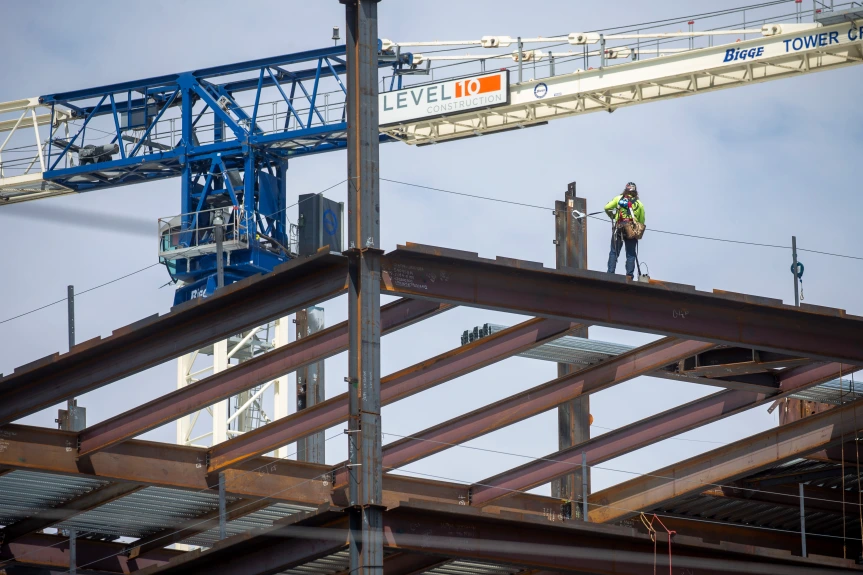Mathew Reed, Policy Director with SV@Home, said the mounting economic uncertainty will require officials at all levels of government to remove barriers to development and unlock more money for desperately needed affordable homes. “Because there are ongoing challenges, there’s a lot we can do that’s going to be critical in the longer term,” Reed said. The Housing Element process, going on now in all Bay Area jurisdictions, is an important opportunity for each city to identify constraints and barriers to housing development and make plans to offset or remove them. Successful Housing Elements are key to ensuring the region’s ability to meet the needs of residents, both now and in the future.
By Ethan Varian | evarian@bayareanewsgroup.com | Bay Area News Group
The Bay Area, already one of the most difficult and expensive places in the nation to build new homes, is being buffeted by a turbulent economy that’s creating even more challenges for a region reeling from a housing affordability crisis.
The headwinds are plenty: Higher interest rates for construction loans. Rising labor and material costs. Slowing demand from homebuyers squeezed by more expensive mortgages. And fears of a looming recession as cities continue to recover from the pandemic.
That’s all raising the specter of a widespread housing construction downturn.
“There already is a slowdown, but I think it will magnify itself in 2023,” said Ken Rosen, chair of UC Berkeley’s Fisher Center for Real Estate and Urban Economics. “A lot of developers may put projects on hold until construction costs come down.”
The decline threatens to thwart the Bay Area’s effort to meet its state-mandated goal of approving more than 441,000 homes of all income levels over the next eight years, representing a roughly 15% increase in the region’s housing stock. Already, most cities and counties haven’t come close to meeting their individual targets in past decades. And housing experts and advocates contend that chronic underproduction — in part because many local officials have sought to limit growth — is at the root of the region’s astronomical rents and home prices.
Mathew Reed, policy director with Silicon Valley pro-housing group SV@Home, said the mounting economic uncertainty will require officials at all levels of government to remove barriers to development and unlock more money for desperately needed affordable homes.
“Because there are ongoing challenges, there’s a lot we can do that’s going to be critical in the longer term,” Reed said.
Signs of a homebuilding decline are already clear. From the start of last year through November, the San Francisco metro area — which includes the East Bay and Peninsula — permitted just over 10,000 homes, a 16% decline from the same period in 2021, according to U.S. Census Bureau data. The San Jose metro area, which has seen a spate of new housing planned for its urban center, actually saw permits increase from around 4,000 to 6,000 new units.
But just because projects have construction permits, that doesn’t automatically mean they’ll be built. In San Francisco, for instance, several of the city’s biggest housing developments are reportedly stalled. And in Concord, a 16,000-unit megaproject still in the planning stages is on hold after the developer asked the city to approve the addition of about 3,000 more homes to offset growing costs.
“You have deals going to the sidelines because of interest rates,” said Chris Neighbor, president of SummerHill Homes, which develops houses, condos and apartments throughout the South Bay.
The rising cost of borrowing has sent typical mortgage rates doubling over the past year, to 6.3% last week, boosting monthly home payments by thousands of dollars and pushing many would-be buyers out of the market. In turn, developers are increasingly pulling back on new single-family homes and condos.
On top of that, financing projects has become more expensive as rates for construction loans also have jumped to around 6%. Neighbor said that’s adding roughly $20,000 to the per-unit cost of large multimillion-dollar developments – a seemingly small amount that can still make all the difference.
“That just upended all of the financial models that determine whether or not something is a feasible project,” said Chris Thornberg, an economist and founder of Beacon Economics.
Another roadblock: swelling material and labor costs since the start of the pandemic. Neighbor said inflation and supply chain issues for lumber and other materials, coupled with worker shortages, have sent hard costs soaring by around 20% the past few years, though prices are now starting to stabilize.
The cost of lumber, which has been especially volatile during the pandemic, recently returned to pre-COVID levels. Prices averaged around $377 per thousand board feet this month, down from a peak of $1,495 in May 2021.
Dean Wehrli, a principal with John Burns Real Estate Consulting, said tens of thousands of local layoffs by tech companies such as Facebook, Twitter and Salesforce also are having a “big impact on housing demand,” giving developers pause. And growing concerns about a recession freezing the local real estate market later this year are only increasing the uncertainty.
At the same time, the slow pandemic recovery of the region’s urban cores has some developers questioning whether it makes sense to pursue projects in city centers, where rents largely haven’t returned to pre-COVID prices.
“Why would you want to live in a downtown if it is dark and empty and boarded up?” asked Danny Haber, chief executive of Oakland-based developer oWOW.
Meanwhile, affordable housing developers are facing yet another set of challenges. Most low-income projects rely on public subsidies that have become increasingly oversubscribed in recent years and could soon be on the chopping block amid economic uncertainty.
Last week, Gov. Gavin Newsom, facing a projected $22.5 billion deficit, released a new budget proposal calling for $350 million in reductions from the $11.2 billion set aside for affordable housing programs over the next few years.
Abram Diaz, policy director with the Non-Profit Housing Association of Northern California, said the prospect of even greater cuts during a recession is one reason why advocates and officials are working toward bringing an unprecedented Bay Area affordable housing bond worth up to $20 billion before local voters in 2024.
“In the tough times, that’s where we’ll see how committed we are to addressing this crisis,” Diaz said.
Matt Regan, a housing policy expert with the pro-business group Bay Area Council, blamed cities’ sometimes yearslong approval process for adding crushing costs to both affordable and market-rate projects. Local zoning rules have also put overly strict limits on how many homes can go where, he said.
While the state and local governments have phased in reforms, more needs to be done to rebalance the housing market in the Bay Area, Regan said.
“If it’s not already a gated country club for millionaires,” he said, “it will become that very soon.”

